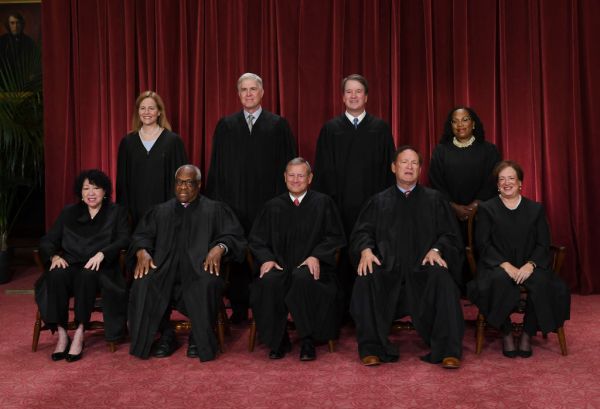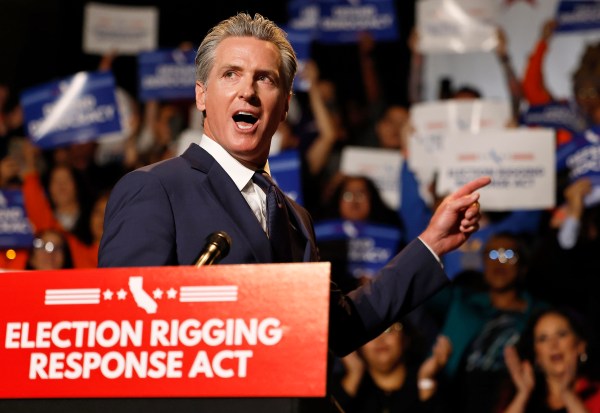In the wake of the Supreme Court’s ruling in the United States v. Skrmetti, which upheld Tennessee’s law prohibiting minors from accessing medical transition procedures, Time called the decision a “major blow to transgender rights.” The Advocate asserted that the ruling is “devastating to trans youth and their families” who will now need to travel across state lines to access “needed care, which is often lifesaving.” The Advocate went on to quote California Attorney General Rob Bonta, who declared: “Across the nation, we’ve seen a rise in hate-fueled violence and intimidation against our LGBTQ+ community, and laws such as Tennessee’s Senate Bill 1 only serve to exacerbate these conditions by blatantly discriminating against transgender youth and denying them access to critical lifesaving care.”
While progressive media often speculate about the impact of “anti-trans” laws and regulations on the mental health of “trans kids,” they often fail to consider how their grim and fatalistic messaging might impact the same youth. And they should, especially when considering that trans-identified youth are often psychologically vulnerable and suffer from mental health disorders at elevated rates. Indeed, while the media often attributes psychological distress to “anti-trans” policies themselves, what if that media’s sensationalist rhetoric is also a factor in that distress?
Like the Skrmetti decision, the responses to the Trump administration’s executive orders on sex and gender have been full of apocalyptic rhetoric that presents the policies as a “direct assault on LGBTQ+ Americans.” From Vox, readers learn that “The Trump administration is already hurting trans kids,” and from The Nation, that Trump is waging an “Anti-Trans War.” And it’s not just the headlines: Shortly before the election, Time predicted that a second Trump term would pose “existential” and “literal threats” to “trans kids.” A Buzzfeed article declared that Trump’s executive order prohibiting federal funds from being used to promote “affirming care” for persons under 19 is an “obvious matter of survival,” while citing dubious statistics about suicide and suicidality.
Dubious, that is, because there is no strong evidence that being denied medical transition leads to suicide. The Department of Health and Human Services’ (HHS) report in May on best practices for treating pediatric gender dysphoria echoed the U.K.’s Cass Review in concluding that there is “no evidence that pediatric medical transition reduces the incidence of suicide.” Even Chase Strangio, the trans-identified lawyer who represented the American Civil Liberties Union in Skrmetti, conceded under oath that “completed suicide, thankfully and admittedly, is rare.” Furthermore, after activists reported that there was a wave of suicide deaths in England after the National Health Service began restricting access to puberty blockers, the NHS asked psychologist Louis Appleby to audit patient data provided by NHS gender services. Appleby’s report concluded that there was no increase in suicides—and that the coverage of the issue on social media is “insensitive, distressing and dangerous, and goes against guidance on safe reporting of suicide.”
Nevertheless, in response to Trump’s executive order prohibiting funds from going to education programs that allow natal males to compete in girls’ and women’s sports, radio host Emma Vigeland irresponsibly tweeted, “Let’s recreate the Tim Walz photo op, but instead of feeding children in school how about we drive some trans kids to suicide.” It seems that at least some trans-identifying youth have internalized such a message: The LGBT youth organization the Trevor Project reported that they received a 700 percent increase in calls to their crisis hotline the day after Election Day in 2024, compared to preceding weeks.
It seems clear that progressive media outlets help create this frightening perceptual climate: Their messaging often fails to acknowledge that there is no high-quality evidence that gender “affirming” care improves symptoms of dysphoria or resolves co-occurring psychiatric issues.
For example, Grace Byron in the New Yorker speculates that concerns about the scientific basis for pediatric medical transition are really just plausible cover for a broader agenda to erase trans people. “But the White House’s goal isn’t just no new trans kids; it’s no trans people, period,” Byron writes. She goes on to add that “curtailing care for trans adults was always part of the larger conservative plan.” Moreover, after the release of the HHS report on pediatric gender dysphoria, Teen Vogue rejected the report’s embrace of exploratory psychotherapy as a treatment with a more favorable risk-benefit ratio, equating it with conversion therapy. “Transgender youth don’t need to be changed,” the author wrote. “It’s the systems harming them that do.” Or consider this recent article in the Hartford Courant that irresponsibly suggests Connecticut hospitals that announced they would cease offering pediatric medical transition will leave “hundreds of young people without lifesaving care.”
But more subtly, the media also falls short by projecting a kind of fatalism that conforms with what Greg Lukianoff and Jonathan Haidt call “reverse cognitive behavioral therapy.” If the goal of cognitive behavioral therapy is to help correct distorted and maladaptive beliefs through “mental reappraisals,” then reverse cognitive behavioral therapy achieves the opposite: It reinforces a set of disempowering and false beliefs about the nature of the world and our place in it. Haidt, a social psychologist, speculates that these disempowering messages reduce one’s sense of personal agency—and in turn, this lack of agency can culminate in feelings of helplessness, making one more susceptible to mental health issues. Although Haidt has never applied this theory to media coverage on transgender issues, it’s easy to see a theoretical connection. Trans-identified youth are constantly bombarded with some variation of, as the ACLU puts it, “The cruelty is the point, and Republicans want to deliberately harm transgender people by taking away their unambiguous legal right to ‘lifesaving’ care.” The belief also reinforces the cultural script that distress is a logical consequence of “anti-trans” laws.
Media fearmongering is especially worrisome given that many trans-identified youth have mental health issues and heightened emotional sensitivity that often predates their experience of gender dysphoria. While few researchers have studied the personality traits of trans-identified youth, there are reasons to believe that disproportionately high rates of internalizing symptoms and disorders—conditions like anxiety, depression, and PTSD—can be partly explained by a neurotic temperament, which is, in this context, a dispositional vulnerability for a host of psychological disorders. Trait neuroticism is often characterized by a tendency to experience more negative emotions, and also by emotional instability and sensitivity to stress. Because neuroticism is consistently linked with mental health disorders, individual differences in trait neuroticism may shed light on the disproportionately high rates of psychopathology among the trans-identified, particularly among “late onset” dysphoric youth.
Dovetailing with this, in a 2018 study, the researcher Lisa Littman noted that the parents of many gender dysphoric adolescents and young adults report that their children have psychiatric diagnoses that predate their dysphoria, and are often overwhelmed by their emotions, struggling to regulate them in constructive ways. Notably, neuroticism and mental health disorders more generally are also associated with perceptual biases, like the tendency to interpret normal situations as threatening.
This tendency to “interpret normal situations as threatening” is worth lingering on.
There is a lot of overlap between a neurotic temperament and what is called “rejection sensitivity.” When researchers Downey and Feldman first conceptualized rejection sensitivity in 1996, they described it as a “cognitive-affective processing disposition” that manifests itself as the tendency to “anxiously expect, readily perceive, and intensely react to rejection.” Interestingly, rejection sensitivity is a feature of many of the co-occurring conditions—depression, anxiety, post-traumatic stress disorder, ADHD, and autism—observed among trans-identified youth and young adults.
Rejection sensitivity—as a temperamental vulnerability or as an artifact of other mental health issues—could be a skeleton key for unlocking a compelling alternative interpretation of self-report surveys, which are used to advance “minority stress theory.” Minority stress theory presupposes that elevated rates of psychiatric disorders among the trans-identified are best explained by “discrimination” and “stigma,” including policies that restrict access to “affirming care.” This position is adopted by many civil rights organizations, and until recently, it was the default position of the National Institutes of Health.
J. Michael Bailey, a psychology professor at Northwestern University, has launched the most spirited critique of minority stress theory, arguing that the theory is still in the evidence-gathering stage and has yet to seriously grapple with rival hypotheses. Because minority stress theory is chiefly supported by self-report surveys, Bailey’s core challenge is that the theory is vulnerable to the argument that self-reports of “stigma and discrimination” are better explained by dispositional factors and mental health status—like rejection sensitivity—rather than by objective experiences of discrimination.
This alternative hypothesis dovetails nicely with an aspect of minority stress theory, which emphasizes that “proximal minority stressors” are simply interpretations of ambiguous scenarios that result in subjective appraisals of felt discrimination or stigma—think “microaggressions.” These are contrasted with “distal” minority stressors, which are tied to objective discriminatory events.
While some theorists like Brian A. Feinstein concede that rejection sensitivity plays a role in the experience of “proximal minority stress,” they presuppose that rejection sensitivity is still learned from early experiences of rejection based on a minority identity. This explanation, however, does not hold up for many trans-identified youth today, who often do not have childhood histories of gender dysphoria or cross-sex behavior. By contrast, Bailey argues that rejection sensitivity is more of an inborn, dispositional aspect of personality. Bailey also quotes Dr. Anne Lawrence, a trans-identified researcher, who similarly speculates that “researchers will eventually discover that temperament is a neglected variable” in the research literature on minority stress among the trans-identified.
None of this means, however, that rejection sensitivity among trans-identified youth can’t also stem from genuine experiences of social ostracization. In 2015, the Finnish researcher Riittakerttu Kaltiala-Heino acknowledged that gender-dysphoric youth in a clinic sample reported high rates of bullying, but 73 percent reported that the bullying took place before they began to think about their “gender identity.” That same percentage also reported that they were bullied for reasons other than their “gender presentation” or “sexual identity.” Of course, bullying and the emotional pain of these youth should be taken very seriously. But that doesn’t mean that their pain in the present comes entirely from hostility toward their identities.
With this context in mind, the media’s nightmarish framing of the Trump administration’s policy decisions—and any position that advocates restricting transition treatments—seems lab-engineered to trigger rejection sensitivity among sex-distressed youth. If youth high in rejection sensitivity are biased toward perceiving rejection and reacting with extreme distress in the face of “neutral or ambiguous” cues, then you can imagine the emotional response to Bloomberg unambiguously asserting that the “cruelty is the point in attacks on transgender teens.”
In fairness to critics, the Trump administration has not always helped turn down the temperature. It has leaned into rhetoric that seems to confirm what many already believe about the animus driving opposition to sex-rejecting procedures for minors. While the administration should not get a free pass for its lack of tact or sensitivity, the fact remains that its policies are scientifically and ethically justifiable. Framing opposition to this curtailment as “discrimination” not only misses the mark, but it flattens all the nuanced reasons why people continue to raise alarms about gender medicine, from the instability of gender dysphoria and trans identification, to a lack of safety guardrails and concerns about a minor’s ability to issue informed consent. The “discrimination” framing is also likely to trigger feelings of rejection while reinforcing the perceptual schema that trans-identified kids are under attack, which makes good-faith debate nearly impossible.
In a healthy democracy, people are going to have different values and perspectives. Learning to tolerate and negotiate these differences, though, is part of being a citizen. The media’s implicit message that policy disputes are a threat to one’s well-being and safety leads to emotional solipsism that precludes sex-distressed youth from learning that—to quote journalist Lisa Selin Davis—“just because people disagree with you doesn’t mean they hate you.” While the mainstream media is quick to declare that Republicans are harming—and in fact desire to harm—“trans kids,” they might want to take a long look in the mirror, and at their headlines. We all should.









Please note that we at The Dispatch hold ourselves, our work, and our commenters to a higher standard than other places on the internet. We welcome comments that foster genuine debate or discussion—including comments critical of us or our work—but responses that include ad hominem attacks on fellow Dispatch members or are intended to stoke fear and anger may be moderated.
With your membership, you only have the ability to comment on The Morning Dispatch articles. Consider upgrading to join the conversation everywhere.